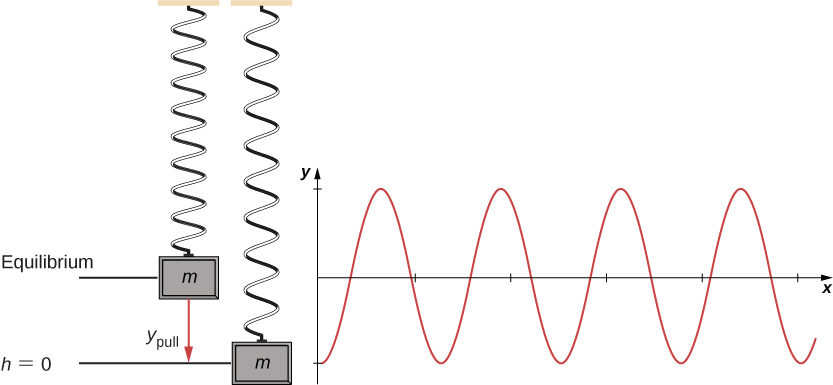| << Chapter < Page | Chapter >> Page > |
Check Your Understanding When the length of the spring in [link] changes from an initial value of 22.0 cm to a final value, the elastic potential energy it contributes changes by Find the final length.
22.8 cm. Using 0.02 m for the initial displacement of the spring (see above), we calculate the final displacement of the spring to be 0.028 m; therefore the length of the spring is the unstretched length plus the displacement, or 22.8 cm.
A simple system embodying both gravitational and elastic types of potential energy is a one-dimensional, vertical mass-spring system . This consists of a massive particle (or block), hung from one end of a perfectly elastic, massless spring, the other end of which is fixed, as illustrated in [link] .

First, let’s consider the potential energy of the system. Assuming the spring is massless, the system of the block and Earth gains and loses potential energy. We need to define the constant in the potential energy function of [link] . Often, the ground is a suitable choice for when the gravitational potential energy is zero; however, in this case, the lowest point or when is a convenient location for zero gravitational potential energy. Note that this choice is arbitrary, and the problem can be solved correctly even if another choice is picked.
We must also define the elastic potential energy of the system and the corresponding constant, as detailed in [link] . The equilibrium location is the most suitable mathematically to choose for where the potential energy of the spring is zero.
Therefore, based on this convention, each potential energy and kinetic energy can be written out for three critical points of the system: (1) the lowest pulled point, (2) the equilibrium position of the spring, and (3) the highest point achieved. We note that the total energy of the system is conserved, so any total energy in this chart could be matched up to solve for an unknown quantity. The results are shown in [link] .
| Gravitational P.E. | Elastic P.E. | Kinetic E. | |
|---|---|---|---|
| (3) Highest Point | |||
| (2) Equilibrium | |||
| (1) Lowest Point |


Notification Switch
Would you like to follow the 'University physics volume 1' conversation and receive update notifications?